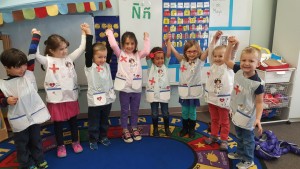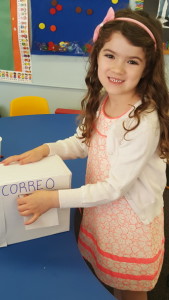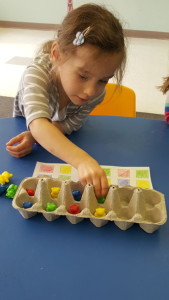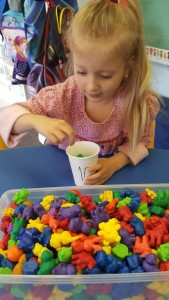Los servicios públicos
 This week we continued working with“Servicios Públicos y/o Ayudantes de Mi Comunidad/ Community Helpers” unit. So, this week we were working with Community Helpers “Medical Profesions”, Doctors and Nurses. We spoke to the children about what a nurse is and what a doctor is and what they do. The students learned about how they help them when they are sick, about the different tools they use during procedures, the different kinds of doctors such as dentist/dentista, and pediatrician/pediatra. Also, they learned how nurses are such important people. Not only are they often the first health care professional that a sick or injured person sees, but they do their job in all kinds of setting.
This week we continued working with“Servicios Públicos y/o Ayudantes de Mi Comunidad/ Community Helpers” unit. So, this week we were working with Community Helpers “Medical Profesions”, Doctors and Nurses. We spoke to the children about what a nurse is and what a doctor is and what they do. The students learned about how they help them when they are sick, about the different tools they use during procedures, the different kinds of doctors such as dentist/dentista, and pediatrician/pediatra. Also, they learned how nurses are such important people. Not only are they often the first health care professional that a sick or injured person sees, but they do their job in all kinds of setting.  We discussed, in circle time, where nurses work. Some of them said that nurses work in hospitals, doctors’ offices, and that’s right, but also, they learned that they can find a nurse in school and in their neighborhood too, because some nurses work directly in the community! Some of these neighborhood nurses teach people with special health problems and help them to manage their conditions, as well they also might travel to a person’s home to provide care for those who are too elderly or sick. As well, they learned that nurses do more that provide hands on health care, they also give patients and their families compassionate support at a time when they need most.
We discussed, in circle time, where nurses work. Some of them said that nurses work in hospitals, doctors’ offices, and that’s right, but also, they learned that they can find a nurse in school and in their neighborhood too, because some nurses work directly in the community! Some of these neighborhood nurses teach people with special health problems and help them to manage their conditions, as well they also might travel to a person’s home to provide care for those who are too elderly or sick. As well, they learned that nurses do more that provide hands on health care, they also give patients and their families compassionate support at a time when they need most. Kids were so exited learning about health care providers, and after doing our activities they did imaginary play to be nurses and doctors. They had a lot of fun playing with this topic. And to finish the week, kids learned about mail office/ oficina de correos, and the people that work there, as the mailmen or postwoman/ carter. They were so happy making letter for their relatives. It was an amazing experience for kids doing their letter, folding the papers and putting them in the envelope/sobre. Finally they placed the letter in the mail box! Parents, wait for your letter in the mail. 
 We continued reviewing the vocabulary of the month: kids are doing a good job learning this vocabulary!
We continued reviewing the vocabulary of the month: kids are doing a good job learning this vocabulary!Bombero/ firefighter,
Policia/police,
Recolector de basura/ garbage collector,
Soldado, soldier,
Enfermera/nurse,
Doctor/doctor,
Veterinario/vet,
Dentist/dentist,
Cartero/postman or postwoman,
Bibliotecario/librarian,
Maestro/teacher,
Trabajadores de construccion/ construction workers,
Estilistas/stylist,
Reportero/reporter,
Reportero/reporter,
Panadero/baker.
LETRA
This week we continued reviewing the letter Nn/. Be sure to point out the letter that we practice when you are reading. While in United States this letter doesn’t exist in the alphabet, in the Spanish pronunciation is; N (enye). Some examples:
Niño/boy,
Piña/pineapple,
Leña/firewood,
Ñandu/rhea,
Araña/spider.
This week we started working with number 14/ catorce. We had a fun time playing and using different items for sorting and counting. Children have a natural desire to make sense of their world that seems largely out of their control. For that reason, “sorting activities often attract children, and help them see differences and similarities”. Then, we did activities such as counting fourteen/catorce osos. Also, we traced the number 14 (número carorce) to practice the number formation using fine motor skills.
La Figura y Color
We reviewed all shapes the kiddos have learned; circle/circulo, square/cuadrado, triangle/triangulo, rectangle/rectangulo, oval/ovalo, heart/corazon, and star/Estrella and diamond/diamante. Also, kids reviewed the colors that they learned: rojo/red, azul/blue, verde/green, amarillo/yellow, purpura/purple, cafe/brown, anaranjado o naranja/orange, pink/Rosado, baby blue/celeste, black/negro, white/blanco and gray/gris.
Have a good weekend!

